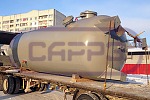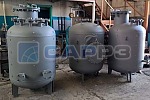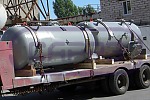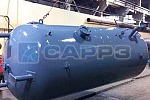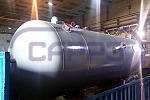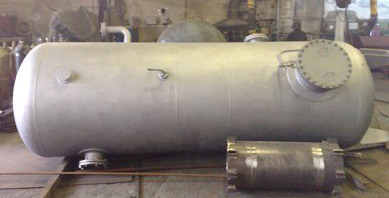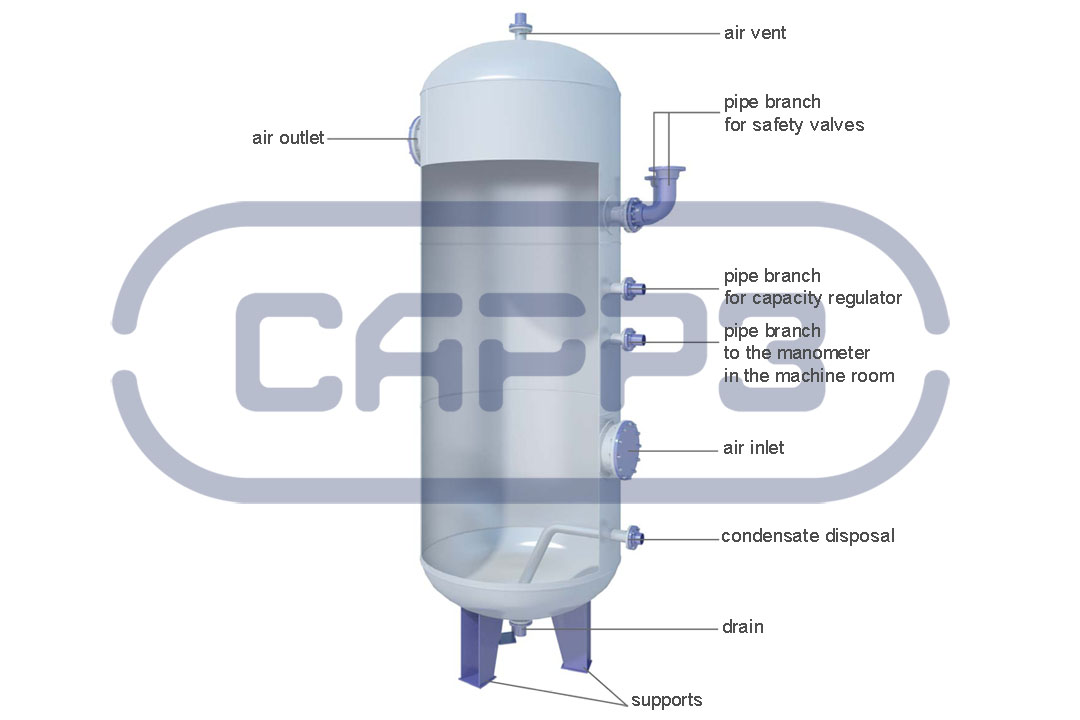Air vessels and gas receivers
|
| ||||
|
| ||||
|
Air collectors (gas receivers) are used in pneumatic process lines to reduce pressure. They are used as a part of compressor units, for storing compressed air, argon, nitrogen and other inert gases in a compressed state, for example, for welding or cleaning operations, in heating systems. They perform the function of smoothing the pressure in the system, stabilizing the gas flow and suppressing the pulsation. They can also collect and store condensate and oils separated from the compressed air, which are naturally formed during the operation.
Design of air vessels and gas receivers
Air vessels are horizontal or vertical cylindrical vessels mounted on supports. Often they are made in the form of the sphere: this form is more reliable and durable, but due to design features and production difficulties spherical air vessels are more expensive.
The choice of horizontal or vertical orientation depends on the operating conditions and the availability of production space, since the performance does not depend on the location method: vertical vessels are more ergonomic, therefore the most commonly used.
When pricing calculation of air vessels particular attention is given to safety valves, which protect against destruction in case of a sudden pressure intensification. Technological equipment is installed in the various fittings and nipples, which guarantees the safe operation of the vessels: pressure gauges, valves, a three-way valve, etc.
Cylindrical air vessels have elliptical heads. In case of a vertical configuration, there is a branch pipe in the head, through which high-pressure gas enters the vessel. In the lower part of the body there is a hatch through which the formed mud and oil sludge are being removed. In addition, the second large diameter hatch is provided for maintenance and inspection.
If the receiver is always operated at low temperatures, it is possible to install a heater that artificially increases the temperature of the operational product. It also allows the deferred oils to thicken less.
To transport air vessels and receivers, "ears" are welded - devices for strapping.
Technical characteristics of air vessels (receivers)
- temperature of operational product - from -60°С to +300°С
- minimum ambient temperature - up to -60°С
- pressure - up to 16 MPa
- volume - from 1 m3 to 200 m3
- seismicity of the region - up to 7 points
Principle of action of air vessels
Compressed air under high pressure enters the receiver through a branch pipe located in the lower part of the shell. Inside, the gas is cooled and expanded. A large amount of air ensures reduction in gas pulsation and balancing of the pressure in the pneumatic system. Due to the free movement of gas, its temperature is further dropping. Temperature drop contributes to the formation of condensate and the oils sludge on the head or in the lower section (if the air tank is installed horizontally). The remaining condensate is removed through a fitting, and the oil sludge is drained through the hatch in the lower section.
Manufacture of air vessels (receivers)
The Saratov Reservoir Plant has necessary Certificates of Conformity for the manufacture of air vessels and gas receivers.
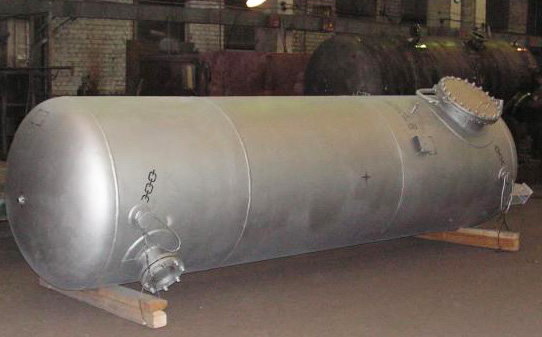 |
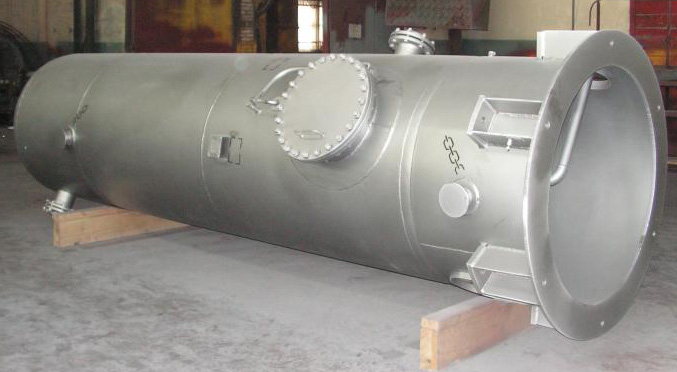 |
The Saratov Reservoir Plant produces air vessels and gas receivers from strong materials that can withstand long-term operation at high pressure (that is, high-power impacts), the chemical effect of corrosive media and have corrosion resistance. As materials alloyed, carbon and chrome steel is used.
The shell is made of steel sheet, which is given the necessary size and shape. Further, the obtained shells are joined together in two ways:
- welding method, when the shells are welded together on a welding key
- by the method of riveting
Any of the methods of receivers manufacturing provides a complete tightness of the seams, and, therefore, guarantees safe operation.
The outer and inner surfaces of the shell are covered with special compounds that extend the service life: first, the composite substances are applied by spraying, and then the surface is dried.
Technical characteristics of air vessels and receivers
| Characteristics | Nitrogen receiver | Oxygen receiver | Hydrogen receiver | Argon receiver | Compressed air receiver |
|---|---|---|---|---|---|
| Effective volume | 1-200 m3 | 0.5-50 m3 | |||
| Operating pressure | up to 16 MPa | ||||
| Temperature of operational product | from -60ºС to +300ºС | from -60ºС to +100ºС | |||
| Ambient class | cold and moderately cold climate | ||||
| Minimum operating temperature | -60ºС | ||||
| Design | cylindrical horizontal/ vertical shell and elliptical heads | ||||
| Steel grade | 09G2S, 12Х18N10Т, 10Х17N13M2Т | ||||
| Overall size | by individual order | ||||
The delivery set of the air vessel (receiver) includes:
- product certificate
- additional processing equipment (if requested)
- basic and details designs (if requested)
How to order air vessels at the Saratov Reservoir Plant?
To calculate the cost of air vessels (receiver) manufacturing at the Plant, You can:
- call at +7(8452)250-288
- send filled in Questionnaire or technical requirements (volume, performance requirements, operational product and its characteristics, operating conditions, general description of the production line) at the e-mail
- use the "Request for quotation", form, provide contact information, and we will contact you to clarify the order
Our specialists will select the design of the air vessel and its equipment.
Upon the individual order our experts carry out the delivery of air vessels, tanks and receivers to a worksite and their installation.
